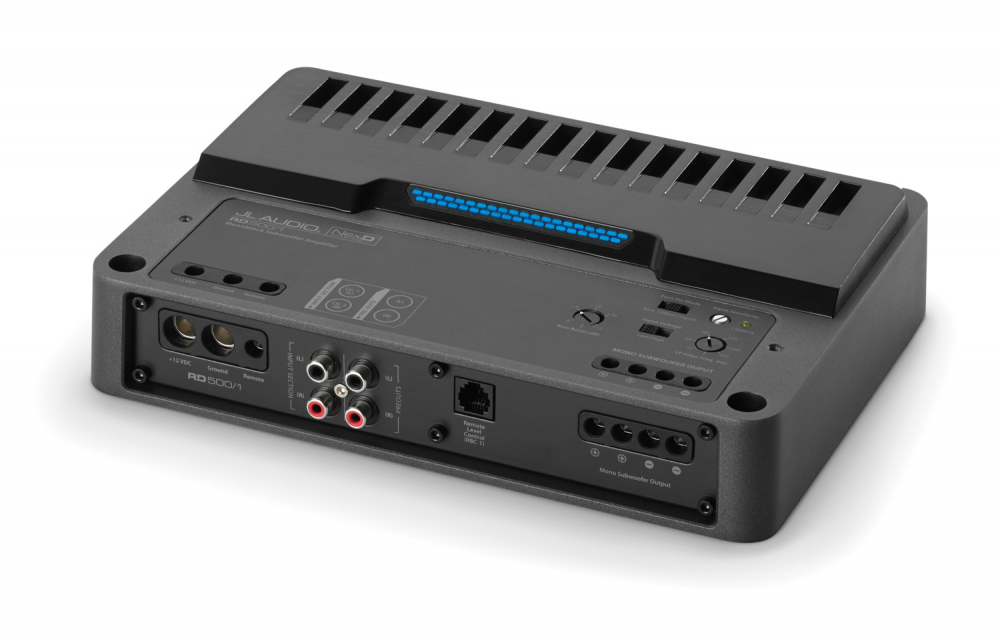
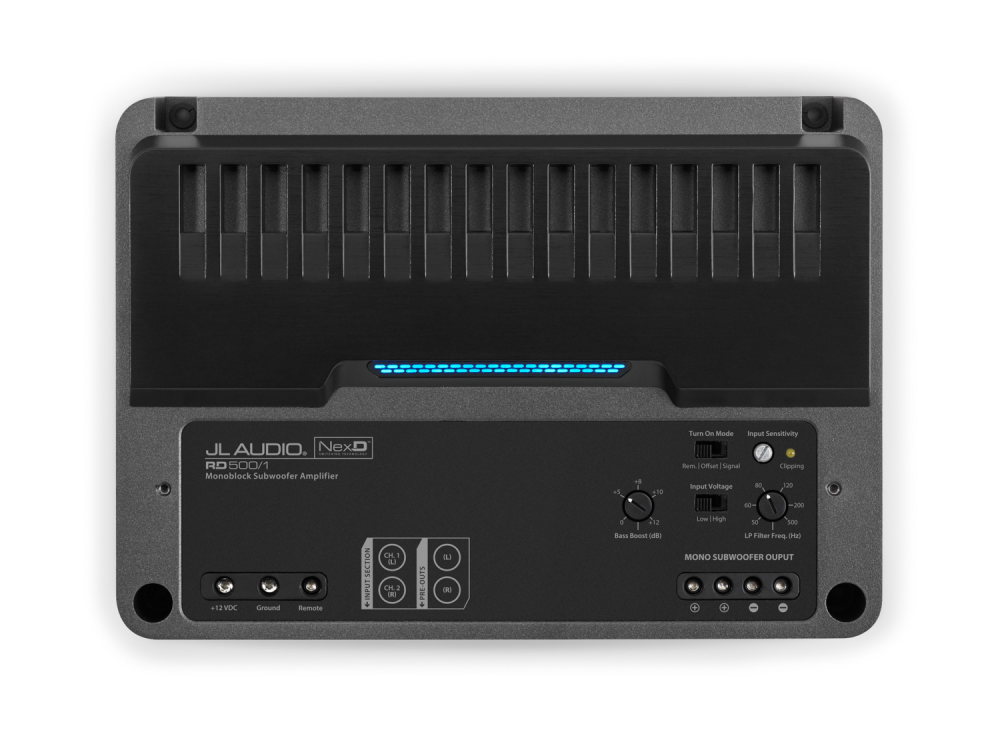
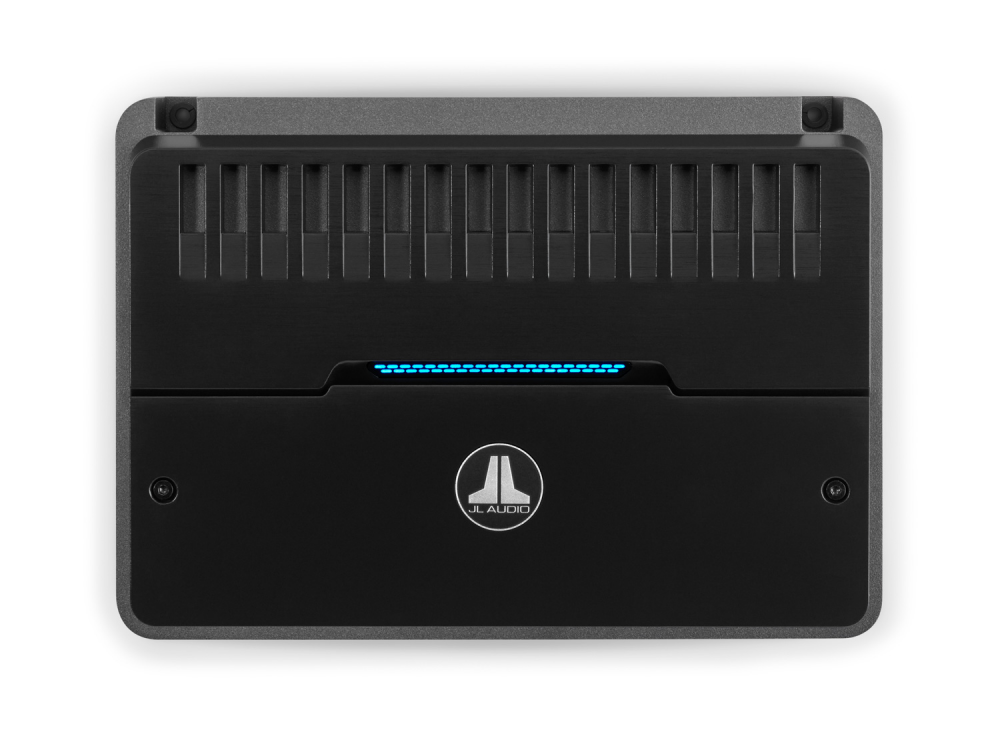
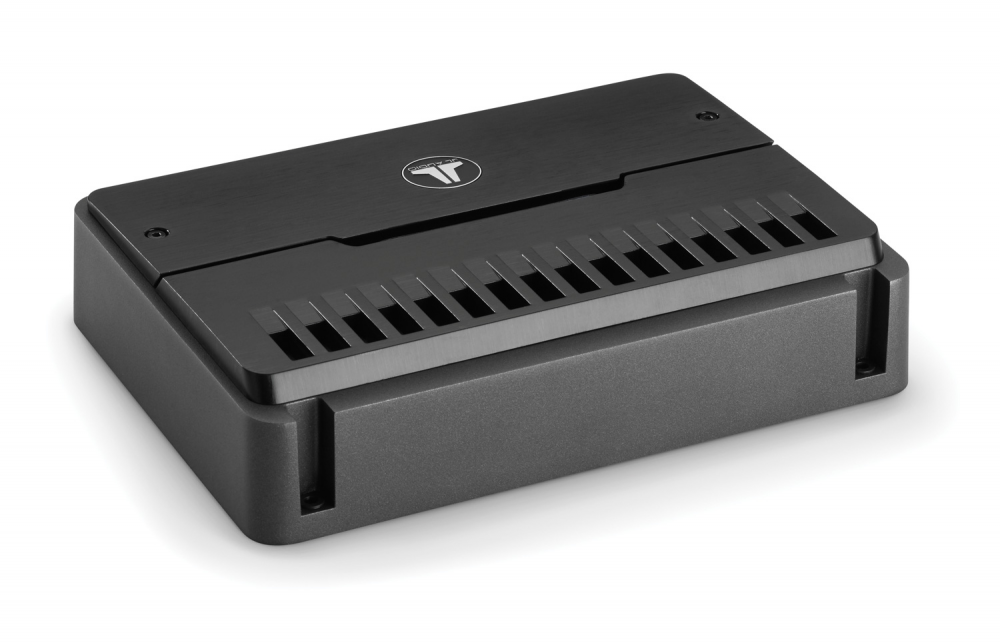

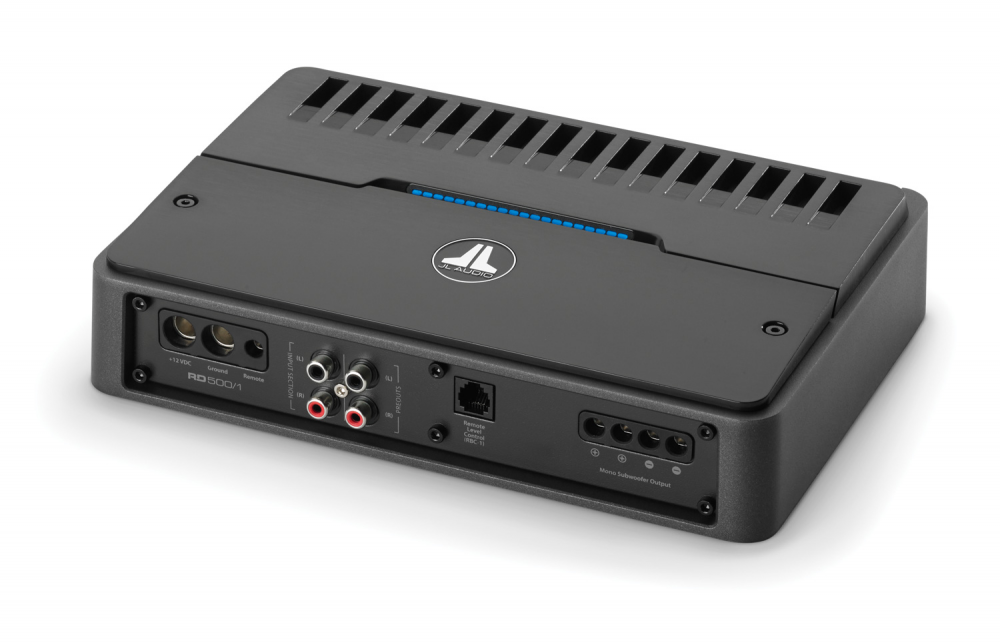
Рождён, чтобы подарить вам колоссальные 500 Вт чистого, неискажённого баса, имея при этом ультракомпактные размеры. Основной секрет заключается в патентованной технологии выходных каскадов NexD, которая обеспечивает одновременно большую выходную мощность, высокий КПД и сверхнизкий уровень искажений.
Для удобства установки и настройки RD500/1 все регуляторы расположены на верхней стороне корпуса под защитной крышкой, а все терминалы подключения выведены на одну сторону. Усилитель оснащён фильтром нижних частот с крутизной 12 дБ/октава и выбором частоты среза от 50 до 500 Гц и системой усиления баса.
Переключаемая чувствительность входов и их построение по дифференциально-балансной схеме позволяют усилителю работать с источниками, имеющими разные уровни выходного сигнала. В оснащение также входит система автоматического включения усилителя (по наличию полезного входного сигнала или появлению постоянной составляющей) и линейные выходы, позволяющие добавлять в систему другие усилители.
Корпус усилителя имеет прочное порошковое покрытие. Светодиодная полоса выполняет не просто декоративную функцию, а служит ещё и двухцветным индикатором состояния усилителя. Дополнительно RD500/1 оснащён индикатором клиппирования выходного сигнала, который позволяет выставить входную чувствительность усилителя быстро и точно, без применения специального оборудования.
Предусмотрено добавление опционального дистанционного регулятора RBC-1, с которым можно контролировать уровень сабвуфера непосредственно с водительского места.
- Типы фильтров
- Low-Pass only
- Крутизна фильтра
- 12 dB/octave
- Диапазон регулировки фильтров
- 50 Hz - 500 Hz
- Возможность пошаговой настройки частоты среза
- No
- Возможность отключения фильтра
- No
- Сабсоник фильтр
- No
- Басс буст
- Yes
- Переключатель полярности
- No
- Проводной пульт регулировки уровня сабвуфера
- Optional (RBC-1)
- Дистанционная регулировка басс буст
- No
- Линейные выходы
- Buffered
- @ 4 Ома
- 225 W RMS x 1
- @ 3 Ома
- 300 W RMS x 1
- @ 2 Ома
- 400 W RMS x 1
- @ 1.5 Ома
- N/A
- @ 4 Ома
- 225 W RMS x 1
- @ 3 Ома
- 300 W RMS x 1
- @ 2 Ома
- 400 W RMS x 1
- @ 1.5 Ома
- N/A
- Частотный диапазон
- 7 Hz - 500 Hz (+0, -1dB)
- Отношение сигнал/шум измеренное на максимальной мощности
- >80 dB below rated power (A-weighted, 20 Hz - 20 kHz noise bandwidth)
- Отношение сигнал/шум (1 Вт)
- >60 dB (A-weighted, 20 Hz - 20 kHz noise bandwidth)
- Демпинг фактор @ 4 Ома
- >1000 / 50 Hz
- Демпинг фактор @ 2 Ома
- >500 / 50 Hz
- Коэффициент гармонических искажений
- <1% @ 2 Ω per Ch.
- Чувствительность входов @ RCA
- Switchable from 200 mV - 2 V RMS (Low) to 800 mV - 8 V RMS (High)
- Рекомендованное сечение кабеля питания с проводниками из 100% меди
- 4 AWG wire
- Номинал предохранителя
- 50 A (AFS, AGU or MaxiFuse™)
- Высота (H)
- 2.13 in / 54 mm
- Ширина (W)
- 9.78 in / 248 mm
- Глубина (D)
- 6.96 in / 177 mm
NexD™ Switching Technology

NexD™ Switching Technology
Summary:
NexD™ amplifier technologies produce exceptional audio quality, unsurpassed total efficiency and high power from very compact amplifier designs.
Detailed Information:
Beginning with the original 'Slash' subwoofer amplifiers, JL Audio has been at the forefront of Class D amplifier design. Today, our flagship Single-Cycle Control™ technology sets the ultimate standard for Class D amplifier performance. The NexD™ amplifiers may be a bit less complex, more compact and more affordable, but they flow from the same minds that have set the trend in mobile amplifier technology for over a decade.
Let's get a little nerdy... A traditional PWM switching amp design uses a fixed switching frequency and varies the pulse width based solely on the audio input signal to the pulse modulator. This basic approach assumes some ideal conditions, like a rock-steady power supply, that do not necessarily occur in a real, in-car installation. Power supply sag with signal causes distortion at all power levels with these designs, even well below clipping. The cure for this is feedback (a corrective signal sent back to the input side), but this becomes impractical as the audio frequency increases, making it a good solution for band-limited (subwoofer) amps, but not for full-range amplifiers.
Taking the above into account when designing the NexD™ subwoofer amplifiers, we have taken the simple fixed PWM approach and enhanced it with a very high switching frequency: 240 kHz, which is about 4x higher than most Class D subwoofer amplifiers. This pushes the amplifier's bandwidth to at least 500 Hz with minimal distortion and improves efficiency, while keeping typically bulky circuity more compact. Your subwoofers will reward you with tight, rock-solid bass performance.
For the full-range NexD™ amplifiers and channels we applied a variable, ultra-high speed version of the NexD™ technology (switching at well over 400 kHz). In these designs, a self-oscillating modulator with "feed-forward" sends information about the instantaneous power supply voltage to the modulator, combining this with the input signal to cancel out any distortion due to supply voltage fluctuation. This reduces distortion prior to applying feedback, simplifying the overall feedback loop design.
The bottom line is simply great audio: clean, powerful and reliable.
Differential-Balanced Inputs

Differential-Balanced Inputs
Summary:
JL Audio’s Differential-Balanced Inputs are engineered to combat induced cable noise, which is a common problem in car and marine audio installations. This technology allows for the use of conventional RCA cables, while delivering many of the benefits of a true balanced connection and accepting a wide range of input signal levels.
Detailed Information:
Today’s vehicles are equipped with sophisticated electronics capable of generating noise and interference that can intrude into the audio path, ruining the listening experience.
Most audio equipment uses single-ended, ground-referenced RCA jacks to receive audio signals. This means that the RCA shield is connected directly to signal ground. This is a simple, cost effective input design that works well for short runs in noise free environments. In noisier environments, this method cannot reject the common mode noise that could be on both RCA conductors (shield and center conductor).
By having more than one chassis-grounded RCA shield on a device, single-ended input designs are also more susceptible to ground loops. If noise is present on both conductors while the shield is connected to ground, the input amplifier will amplify the noise relative to the grounded RCA shield. When there are multiple RCA connections or any other conductors subjected to a magnetic field, this will cause a difference in potential across the RCA loop to be amplified at the grounded RCA as noise (a classic ground loop).
JL Audio’s Differential-Balanced Input circuits measure the center pin of the RCA connection relative to the RCA shield, even when the shield is not connected to ground, and even when the voltages at both conductors are moving relative to ground. Because both the center conductor and the shield see high impedance to ground at the input, a ground loop cannot be formed, as there is no current flow to induce a voltage as noise. This works equally well with differential-balanced, or unbalanced signal sources, making this input architecture compatible with all standard car and marine audio equipment, using standard, unshielded, twisted-pair RCA cables. No special cables are required, unlike the fully balanced connections used in professional audio.
Another benefit of the Differential-Balanced Input design is that it easily accepts low-level and high-level signals from a variety of factory head unit outputs and amplifiers, including single ended “ground referenced” sources, as well as Balanced or Unbalanced “Bridged or BTL” sources. This eliminates the need for Line Output Converters (LOCs) in most installation scenarios.
The obvious question is: “Why don’t all car audio amplifiers use Differential-Balanced Inputs?” The answer is simple: it costs more. Executing a proper differential-balanced input section requires more components and better quality components than a basic single-ended design, so you generally won’t find them on less expensive amplifiers.